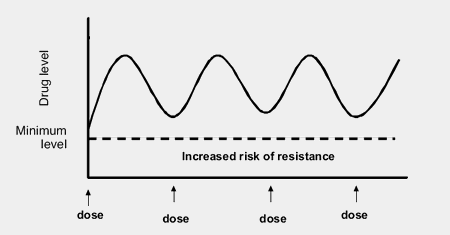2.13 Viral life cycle, drug resistance and adherence
Viral life cycle: copies, mistakes and mutations
When not on HIV treatment (ART), HIV produces billions of new copies every day. In doing this, HIV also makes very small mistakes. These are called mutations.
Before taking ART, every possible single mutation is already being produced.
But drug mutations on ART will be more fit. They can stop the drugs from working. This is called drug resistance.
Resistance, treatment and viral load
Drug resistant mutations stop HIV drugs from working as well. Sometimes they stop working completely.
- The higher your viral load on ART, the higher the risk of drug resistance.
- This is why getting viral load needs to be as low as possible, ideally below 50 copies/mL.
- Drug resistance doesn’t develop when viral load is undetectable (<50 copies/mL).
Resistance and adherence are closely related
Resistance develops when your drug levels are too low. This is why adherence is so important.
Adherence means taking HIV drugs on time, in the right way, every day.
Taking meds late or missing doses increases the risk of drug resistance. The drug levels become too low to control HIV.
ART needs to be taken as prescribed to keep drug levels about a minimum level. This includes following advice to be taken with food or without food.
Drug interactions can also affect the levels of ARV drugs.
- HIV drugs can interact with other HIV drugs.
- They can interact with some OI meds (especially for TB).
- They can interact with some recreational drugs.
- They can interact with complementary and herbal products.
Always tell your doctor and pharmacist about any other medications or treatments that you are taking. This includes products that you buy without a prescription.
Drug levels and resistance
Taking drugs at the exact same time keeps levels well above the level you need.
Each time you take a drug, the drug level increases to stay above this level.

If you are late with a dose, or miss dose, the drug levels fall. If they drop too low, drug resistance can develop.

Missing or being late with one dose will still be okay.
But if you often are late or forget, it makes it easier for drug resistance to develop.
Adherence is not about doing what your doctor says.
Adherence is about you taking control of HIV. It is about always staying above the minimum levels. You want to do this 100% of the time when on ART.
Further reading
i-Base online training course of drug resistance.
This is a learning resource for HIV advocates. It is section 9 of this manual and covers HIV and drug resistance in detail.
Each module should take 30–60 minutes. It was published in 2011 and updated in 2014.
Last updated: 1 January 2023.
